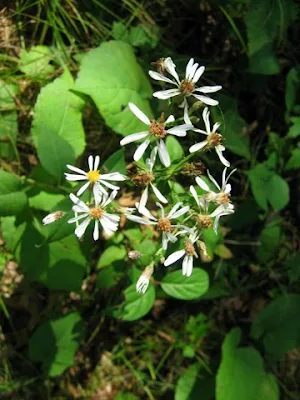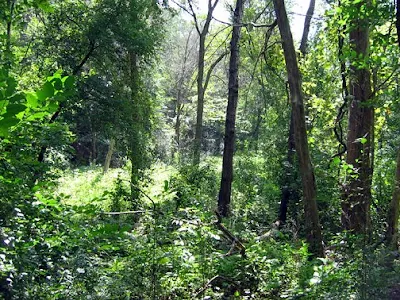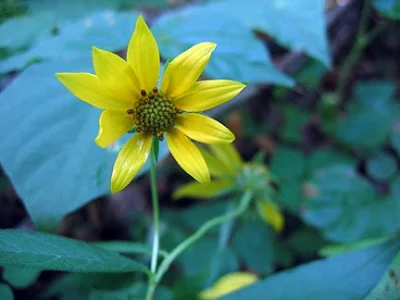A Walk In The Woods
 But Rex, having been a woodsman all his life, assured me that he has never seen so much Indian Pipe in any of his woods. This patch was right beside his trail, the oak leaves piled high from a recent oak death above the spot.
But Rex, having been a woodsman all his life, assured me that he has never seen so much Indian Pipe in any of his woods. This patch was right beside his trail, the oak leaves piled high from a recent oak death above the spot. Rex, who keeps his trails open to his neighbors, excitedly put up a sign identifying the mysterious plant for neighborhood walkers. I was excited to see his sign, I love signs -tell me more.
Rex, who keeps his trails open to his neighbors, excitedly put up a sign identifying the mysterious plant for neighborhood walkers. I was excited to see his sign, I love signs -tell me more.

 This is Hogpeanut, Amphicarpaea bracteata, swamping an area of the woods where a few large trees came down and let in some sunlight. I thought it was a weed, possibly invasive. Instead, it's native to eastern woods, edible, fixing nitrogen in the freshly sunlit soil, and probably is invasive to any garden given half the chance.
This is Hogpeanut, Amphicarpaea bracteata, swamping an area of the woods where a few large trees came down and let in some sunlight. I thought it was a weed, possibly invasive. Instead, it's native to eastern woods, edible, fixing nitrogen in the freshly sunlit soil, and probably is invasive to any garden given half the chance.
Indian pipe, caring not for photosynthesis, crops up even under the hogpeanut.
 Adjacent, in the clearing, new oaks grow on the fallen.
Adjacent, in the clearing, new oaks grow on the fallen. And asters.
And asters.
This clearing, towards the western boundary, is wet, causing much of the trees to fall over in storms. This maintains the clearing, allowing the sun lovers to grow.

Upslope and westerly, the woods abruptly ends at a fence line. Here, goldenrod.
 Standing at the edge of the woods, looking northwest, we stare into the top edge of the gravel pit -so called because it was actually an active gravel excavation pit in the past. On the slope into the woods, piles of glacially rounded stones, and some chunks of concrete remain from those active days. Now the pit is covered with birch trees, some cedar, a very different plant community than just 100 feet to the east. No water stands in the pit, it seeps straight into the greater area aquifer.
Standing at the edge of the woods, looking northwest, we stare into the top edge of the gravel pit -so called because it was actually an active gravel excavation pit in the past. On the slope into the woods, piles of glacially rounded stones, and some chunks of concrete remain from those active days. Now the pit is covered with birch trees, some cedar, a very different plant community than just 100 feet to the east. No water stands in the pit, it seeps straight into the greater area aquifer.
Walking along this trail, on the northern boundary, we enter a valley with sloped sides.
 The recent heavy rains unleashed a torrent down the northern slope. It's hard to make out, but a cleft in the slope, center top, is where the torrent ripped through purely black soil, washing this light gray clay onto the valley floor. It swamped everything in its path. Rex says it will kill the trees growing here. The cleft has been growing every year and there is no will to try to slow the water down that pours through here during heavy rains. There is no humus, no undergrowth to slow the moving water. This is a glacial landscape in flux, hills filling basins.
The recent heavy rains unleashed a torrent down the northern slope. It's hard to make out, but a cleft in the slope, center top, is where the torrent ripped through purely black soil, washing this light gray clay onto the valley floor. It swamped everything in its path. Rex says it will kill the trees growing here. The cleft has been growing every year and there is no will to try to slow the water down that pours through here during heavy rains. There is no humus, no undergrowth to slow the moving water. This is a glacial landscape in flux, hills filling basins. The red dot you may have noticed in the previous photo was a cluster of berries, the fruit of Jack-in-the-pulpit, Arisaema triphyllum.
The red dot you may have noticed in the previous photo was a cluster of berries, the fruit of Jack-in-the-pulpit, Arisaema triphyllum.
First they are green.

Then mixed, finishing up red. These seem to be the only plants that grow in the deep shade under the maples.

Rex is always clearing the fallen twigs and timber, making piles he promises one day to burn.

There are about 8 piles now, all taller than me.
 The southern exposure, which faces the large wetland, is occupied by an army of Buckthorn, Rhamnus cathartica. Can I make the greatest claim for invasive species management? That is a whole understory of buckthorn is really boring to explore. All green, all the time and nothing else.
The southern exposure, which faces the large wetland, is occupied by an army of Buckthorn, Rhamnus cathartica. Can I make the greatest claim for invasive species management? That is a whole understory of buckthorn is really boring to explore. All green, all the time and nothing else.
I don't remember what these berries were attached to.

The occasional woodland sunflower.

The occasional marble. I always find marbles when I am gardening.

Indian pipe is really neat!
ReplyDeleteAh, Indian Pipe!! I used to see it all the time when I lived in northern Wisconsin, in the Chequamagon National Forest. They are such magical little beings - we'd always hunt for them and it was always a delight to come across them. I've never seen them since I left Wisconsin - bummer. Glad you've happened upon them!
ReplyDeleteAimee, I saw them in Forest Park, Queens. I bet they're in Central Park or Prospect Park too.
ReplyDeleteThese, of course, are all in Mn.